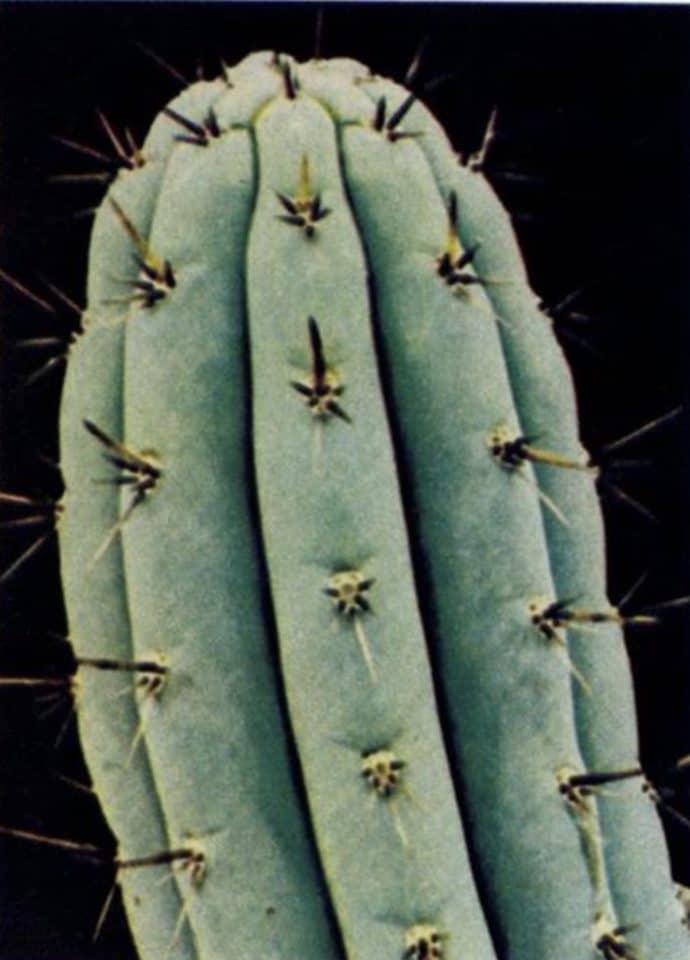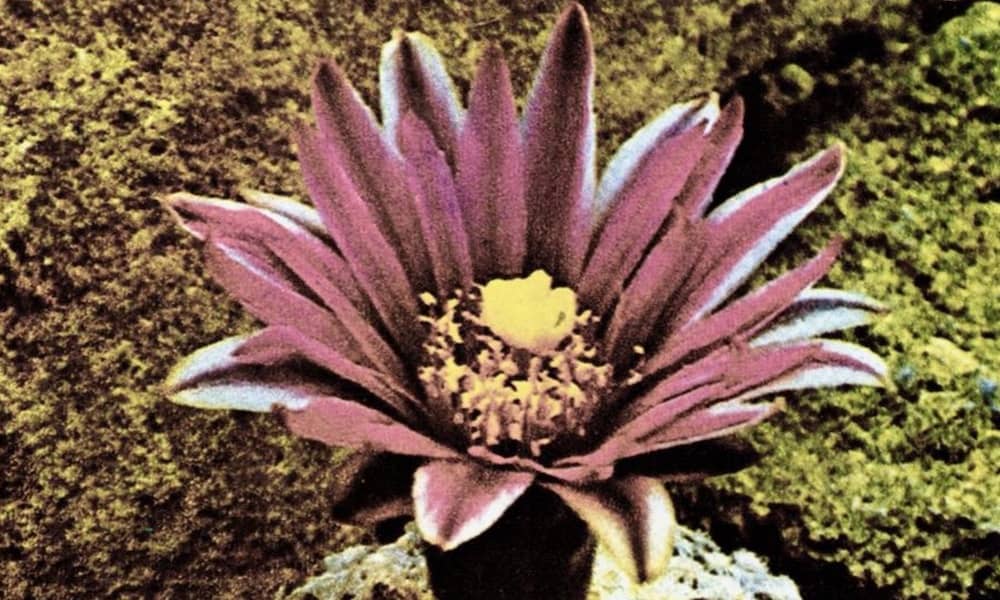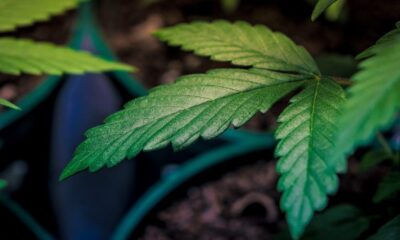featured
Flashback Friday: Psychedelic Cacti
Published
2 days agoon

For this edition of Flashback Friday, we’ve got Robert Lemmo’s concise primer on the varieties of mind-altering succulents from the June, 1977 issue of High Times.
Which cacti will get you high? That depends on your definition of “high,” your metabolism, your culture and mind set and a thousand other factors. An Oto Indian peyotist told Weston La Barre, author of The Peyote Cult, in all sincerity, that peyote doesn’t work outside of prayer meetings—he had tried it.
Most knowledge of psychoactive cacti comes from Mexican and American Indians, especially the native shamans and curanderos (“healers”) who use the plants in religious and visionary contexts. Science has just not gotten on the stick in research into psychoactive cacti. Although use by Indians strongly suggests that many of the alkaloids found in cacti are hallucinogenic, only mescaline, macromerine and gigantine are officially recognized as such. Many alkaloids remain unidentified, and the vast majority of plants go unanalyzed.
Still, existing research, coupled with Indian knowledge of cactus use, enables us to identify about 50 species of cactus that will get you off, in one way or another. However, not every ritual hallucinogen used by Indians makes for a nice recreational high.
By far the best known and loved hallucinogenic cactus is peyote. This is often confused with mescal beans, mescal buttons and mescaline.
The mescal bean, or red bean, is the seed of a small shrubby evergreen, Sophora secundiflora, found in drier parts of the American Southwest and Mexico. The seeds are found in a beanlike pod and contain cytisine, a highly poisonous alkaloid of the nicotine group. Besides inducing visions, these seeds, called frijillitos in Mexico, commonly bring about nausea, convulsions and, if taken in large amounts, death from respiratory failure. Use of mescal beans goes back at least 1,000 years in Mexico and has diminished somewhat since the spread of safer and more pleasant peyotism. But to this day the “Road Man,” the peyote leader of certain Plains tribes such as the Kiowa and Commanche, wears mescal beans as part of his ceremonial dress. Other Plains tribes have been reported to mix peyote and S. secundiflora in a drink—a concoction as cataclysmically potent as Al Capp’s legendary Kickapoo joy juice.
The word mescal properly refers to Agave americana or other Agave species and to the spirits distilled from the beer of the plant, which is called pulque. The genus has over 300 species; some of the common names include century plant and Indian cabbage.
An important point must be made here; Mescal does not contain mescaline. The confusion over these two very distinct psychoactives arose when Arthur Heffter isolated the chief psychoactive agent in peyote in 1896 and called it mescaline. Make no mistake, the powerful drink made from the agave plant and the hallucinogenic peyote brew have very different effects. Unfortunately, the confusion that surrounds them was exacerbated by the name of the Mescalero Apaches, who were peyote users in Heffter’s time, but whose name derived from the agave plant.

Peyote
When peyote cactus, Lophophora williamsii, is dried, the outer edge of the plant curls around the top, giving a buttonlike appearance. Peyote grows on both banks of the lower reaches of the Rio Grande and for quite a distance southward into Mexico. Brewster, Zapata, Jim Hogg, Presidio, Starr and Webb counties in Texas are the most prolific in peyote; the plants are usually found in limestone-desert and desert-scrub areas. The name of the sacred cactus in Nehuatl, the language of the ancient Aztecs, was peyotl, meaning something like white, wooly and/or caterpillar, referring to the plant’s white tufts of hair. This is the term adopted by many of the Plains tribes and later Anglicized to peyote. When early European pioneers of the Southwest and Mexico discovered mescal, they “alcophilically” dubbed it dry whiskey. Carl Lumholtz. a Norwegian explorer-anthropologist-naturalist whose 1902 classic Unknown Mexico remains the most comprehensive account of Mexican cactus use, reported that even straight-shooting Texas Rangers developed a taste for this “dry whiskey.” Taken prisoner in the Civil War and deprived of all manner of booze, the illustrious imbibers soaked peyote (which they called white mule) in water and swilled the tea to transcend the mere physical boundaries of their POW camp. Sounds better than “Hogan’s Heroes.”
People with proper respect for peyote will cut the head off the plant at an angle when collecting it. This way, the root and the bit of plant left in the ground can regrow. A stump decapitated in this way will sprout several new heads on the single rootstock. These clones are considered primo. It is said that the Santo Domingo Indians guarding the Northern Arizona peyote fields will damage people who don’t show this respect. The belief that the woolly tufts of hair on peyote contain strychnine is a fallacy. The hairs act as a terrible irritant to the digestive tract, and eating buttons without first pulling them causes massive internal itch.
There are as many ways to eat peyote as there are to eat chocolate; it’s up to you. You can make tea and drink it, boil it down and stuff it into capsules, mix it with tutti-frutti, wash it down with O.J. or just get into it and chew it up real well, which will leave a strong taste in your mouth but is probably the best way to get off. Descriptions of the raw taste of peyote range from intensely repugnant to mildly disgusting to nice and tasty—this last judgment not uncommon among long-time users.
Speaking of long-time users, evidence of peyote use can be found on west Mexican burial art dating back to the year one, or thereabouts. Use by the Huichol-Cora Indians of the Sierra Madre Occidental may date back further, and it is generally held that the Huichol peyote ceremonies remain closest to pre-Columbian rituals.
The Indian use of peyote is so ancient and complex that it defies anything less than book-length description, offered by La Barre in The Peyote Cult and Artaud in The Peyote Dance, but here’s a spotty glimpse at the plant’s use through history.
How did humans first come to eat the strange-looking button?
According to one of the Indian tribes, in ancient times, a pregnant woman, unable to keep pace with her band of companions, gave birth all alone in the desert. Weak and milkless, without food, she lay under a leafy bush watching the circling vultures, when a voice came to her: “Eat the plant that is growing beside you. That is life and blessing for you and all your people.” She pulled up some of the spongy cacti and ate them. A short time later she revived with enough milk to feed her child and the strength to overtake her companions the same evening. She showed the cacti to her uncle, a curandero, who pronounced the wondrous plant beneficial “for everyone.”
Maybe it was so for that tribe, but according to the four surviving Aztec books of religion, peyote was taken only by high priests.
However, every year, a group of Huichol Indians travels 300 rugged miles northeast of their homes “to find their life” in a reconstruction of the first peyote hunt undertaken by the ancient gods. The first time the gods convened, according to myth, each found he was somehow ill or physically distressed. Tatewari, deity and first of the Huichol shamans, informed them that they were unwell because they had not traveled to the land of Wirikuta (San Luis Potosi), the place to the east, where the sun was born. They were to prepare themselves for a long and difficult journey to the land of peyote and eat neither salt nor chili. Not all the gods made it—Hummingbird Person and Rabbit Person had to abandon the arduous trek. However, the principal gods followed Tatewari to the sacred mountains at the end of the world, where peyote revealed itself to them.
In preparing for the hunt, Huichols undergo a session of purification in which they must publicly announce the name of every lover they have had, the presence of spouses or present lovers notwithstanding. Only the very old are allowed to abbreviate; anyone else whose memory fails is reminded and chided into revealing all adventures. No Huichol would knowingly omit a romance; to go on the hunt in an impure state would subject not only the individual but the whole party to severe spiritual and physical dangers.
Peyote is a relatively new sacrament to the Indians of North America, except in southern Texas, where the cult is at least hundreds of years old. In about 1870 the rest of the Southwest had its psychedelic revolution, which involved the famed Mescalero Apaches. The Kiowa and Commanche were in the vanguard of peyotism among the Plains Indians, who in general look to peyote like Wimpy to hamburgers.
Many see this boom as a reaction against the corrupting influence of the white man. The peyote rituals renewed the Indians’ contact with the earth, their gods and their ancestors; the drug was considered a cure for alcoholism, tuberculosis and venereal disease—ailments unknown in America prior to the Europeans’ arrival.
Peyote has always been recognized as strong medicine. When collecting the cactus, the Huichols touch it to the forehead, heart, eyes and throat for its benign influences. Both Indian healers and early U.S. Army medics used it as a painkiller, and fresh buttons are used today to make poultices for fractures and snake, insect and animal bites. A woman of the Native American Church told me of a friend who put a split green button on a black-widow spider bite immediately after the little creep struck. Two hours later the victim had no fever or pain, and the wound was no more inflamed than a wasp’s sting. She also told me that many people like to consume peyote as a tonic, one a day.
In 1933, a Swiss pharmacy launched an extensive advertising campaign for their new tonic , Peyotl, which claimed to “restore the individual’s balance and calm and promote full expansion of his faculties.” But in 1939 the League of Nations convinced the Swiss to sell the drug only on prescription—another tragic blow to the short but sweet run of dynamic drugstore tonics. One of the most effective advocates of peyotism was Quanah Parker, a half-breed Commanche leader from south Oklahoma who was taken deathly ill with an unknown ailment and given up as doomed. He was cured by a local curandero with peyote. Soon anthropologists observed many apparently successful treatments of rheumatism, fevers and a whole array of vexations, and “modern science” decided to take a look at the bountiful button. University of Arizona researchers have separated a water-soluble, crystalline substance from an ethanol extract of peyote that they report exhibits antibiotic activity against a whole spectrum of bacteria. The name peyocactin has been given to the principal antimicrobial component; of particular interest is its inhibitory action against 18 strains of penicillin-resistant Staphylococcus.
Peyote is quite beneficial to mental health when taken in the context of peyote meetings—group therapy sessions where life anxieties are worked out with the support of friends, the shaman, a rich religious tradition, positive power objects and illuminating mescaline. Meetings, which are usually held once or twice a month on Saturday nights and last through the night, concentrate on healing, prayer, the promotion of rain, the celebration of an event or anniversary or simply partying, but always with a respectful attitude. As Quanah Parker said, “The white man goes into his church and talks about Jesus; the Indian goes into his teepee and talks to God.”

Cereus
Saint Peter is the most popular hallucinogenic cactus after Father Peyote. San Pedro is the name given a number of the species of Trichocereus that contain mescaline. Most commonly, it refers to T. pachanoi, a tall, columnar cactus that branches from the base and reaches heights of 20 feet. It has a varying number of prominent ribs (most commonly, seven). The rarer, four-ribbed plants are considered more powerful, and thinner branches are preferred to thick ones.
T. pachanoi contains about 1.2 grams of mescaline per kilo, as well as high concentrations of the powerful alkaloids hordenine, candicine and anhalonine—all found in peyote. Other mescaline-containing species of Trichocereus are T. macrogonus (short brown spines). T. werdermannianus, T. bridgesii (long yellow spines) and T. terschekii (a species from Argentina that reaches heights of 40 feet). Names are very often mislabeled in commercial cactus stores, but species without mescaline include T. camarguensis, T. candicans, T. chiloensis, T. lamprochlorus, T. Peruvianus, T. schickendantzii and T. spachianus. You can get off on these mescalineless Trichs, but it’s not as much fun. People who have tripped on San Pedro describe it as very pleasant and mellow, with all the trippiness of peyote but none of the nausea or body distress.
San Pedro is usually cut into six-inch slices and boiled in four or five gallons of water for at least seven hours before consuming. After it has boiled for several hours the skin can be removed, but this is best not done too soon, since the highest concentration of mescaline is just under the skin. The method of ingestion is optional: you can swill down the soupy liquid or boil it to a gum and stuff it into capsules. No doubt you can eat it raw, but unless you’re prepared to eat the stubs of spines, too, you’ll lose that high quantity of alkaloid right under the skin. Smoking is probably one of the least effective ways to utilize a psychedelic cactus. Boiling is the best: it maximizes the enjoyable and minimizes the disagreeable effects.
The state flower of Arizona grows on a scientifically recognized hallucinogenic plant—the unmistakable, majestic saguaro (Carnegiea gigantea), a fat stick-figure with a number of upraised arms, familiar to every horse-opera fan.
The saguaro has been having a rough time of it lately, its high mortality and low birth rates being variously ascribed to its slow growth in combination with rodents, radiation, moths or changing climate. Those who would damage one of these living leviathans just to get high are liable to be damaged themselves by a cactus lover observing them. However, a little strolling in the desert will soon reveal an age-or wind-fallen specimen large enough to satisfy the psychic needs of an army.
Commonly called organ-pipe cactus, Cereus jamacaru contains the active alkaloids hordenine and tyramine—both present in peyote. Big specimens of the variety, which is native to Brazil, are 30 feet tall and bear eight-inch spines. These tough plants can survive a winter low temperature of 45 degrees Fahrenheit.
Young branches of Pachycereus pectenaboriginum (Indian’s comb) are crushed by the Tarahumari to extract the juice, which they drink with water to produce “dizziness and visions.” It and Pachycereus marginatis contain the alkaloid pilocereine.
Two species of Echinocereus — E. eyriesii and E. merkeri—have been reported to contain hordenine, but virtually no research or analysis has gone into verifying this claim. It will be very fortunate if they are indeed potent, since E. eyriesii, the Easter Lily cactus, is one of the commonest and most easily grown of all cacti and is found in almost any windowsill collection.
FOUR WAYS
Say, have you seen glad hands of hemp upraised
to you in welcome? Have you been amazed
to smell sweet hemped pollen on the air?
Have you felt the bright peyote’s tiny breast
or kissed it? Heroes and poets suckle there,
the alpha and omega of their quest.
Have you heard the morning-glories trumpeting
happy fanfares for the sun ’s rebirth
or tasted the merry mushroom’s mirth
in cool primeval shadows of your mind?
Bush or cactus, fungus or vine, one thing
dwells in each—various, but of a kind—
and it lives in you if you will eat thereof:
a natural grace like the memory of love.
—J.F. Burke

Echinocactus
Echinocactus is the subtribe to which peyote belongs. The Tarahumari Indians respect the psychedelic power of almost all plants now called echinocacti.
Psychoactive echinocacti include those of the genera Ariocarpus, Obregonia, Aztekium, Strombocactus and Gymnocalycium. Ariocarpus retusus and A. fissuratus are known to the Huichol as tsuwiri, or “false peyote.” The plant does not actually look much like peyote, but the Huichols maintain that the cactus can manifest itself as true peyote to those who have not properly purified themselves for the peyote hunt. The Huichol thus shun the intake of Ariocarpus, which they say causes terrible visions, horrible sicknesses of the body, madness and death—the prototypical bummer. Legal-high entrepreneurs sell ariocarpi as “peyote cimarron.” Although ariocarpi contain no mescaline, they are probably not as bad as the Huichol make them out to be. The principal alkaloids are tyramine, hordenine and anhalonine, all in peyote.
Ariocarpi are true mimics, “living rock” cacti that will match exactly the color of the soil or rocks in which they are growing. In their native habitat of limestone-desert-scrub areas in Brewster, Cameron, Maverick and Pecos counties in Texas and Chihuahua and Coahuila states in Mexico, the plants are easily overlooked as weathered limestone. As with peyote, the root of the cactus shrinks in the summer, pulling the head of the plant down into the ground. In cactus collections, these babies aren’t easy to cultivate.
Another “living rock” cactus, which the Nahuatl language refers to as peyotl, is Obregonia denegrii, a plant much like an artichoke, found in northeast Mexico, especially in the state of Tamaulipas. It should be remembered that peyotl means white or wooly in Nahautl, and it may be that the plant is so called simply because it has tufts of white hairs similar to those of peyote, but you can count on just about any echinocactus to contain the powerful alkaloids tyramine and hordenine.

Aztekium is a monotypic genus; that is, it comprises only one species: A. ritteri. Its multiple grooves and ridges give it the appearance of an Aztec sculpture. In addition to hordenine and tyramine, A. ritteri contains a good dose of caffeine.
The “chin” cactus group includes the genus Gymnocalycium, which comprises a number of mescaline-producing species, including G. gibbosum, G. multiflorum and G. platense. No published researchers have looked for mescaline in the other 30 or so species of Gynmocalycium, but it seems a worthy task for any space/time cadet with high goals. However, it should be mentioned that there is a major risk in such exploration. Another alkaloid common to the gymnocalycii is anhalonine, the strychninelike chemical in peyote. Any mammal ingesting a cactus superrich in anhalonine (if there is such a cactus) would find itself seriously lacking in its favorite gas: oxygen. Someone had to eat that first mushroom, right?
Gymnocalycii are called “chin” cacti because of the cleft and protrusion under each tubercle of the plant. Cactus dealers commonly sell similar-looking plants as “gymnos.” The one clue to a true gymno occurs only when the plant is in bud, early spring to July: the flower tubes and stems have a scaly appearance but are smooth to the touch. Edgar and Brian Lamb’s Pocket Encyclopedia of Cacti (Macmillan, 1969) has color photographs of 11 species of Gymnocalycium.
Other cacti of interest in subtribe Echinocactus are the four species of Astrophytum, which contain hordenine and tyramine: A. asterias, A. capricorne, A. myriostigma and A. ornatum.

Mammillaria
Members of genus Coryphantha, commonly called pincushion cacti, have two mescaline-related alkaloids not found in any other cacti. Coryphantha macromeris and C. runyonii contain macromerine and N-methyl-3, 4,-dimethoxy-phenethylamine, both recognized by science as hallucinogens, as well as the old standbys tyramine and hordenine, shown to be hallucinogens by years of practical application. Although specific research hasn’t been done, the similarity of the various species of Coryphantha suggest that others are worth looking into: C. echinus, C. muehlenofordtii and G. vivipara. These are found throughout Arizona. New Mexico and Texas and in northern Mexico.
The genus Mammillaria is often mentioned in accounts of Indian use of cacti, simply because until recently just about any cactus of a certain size and shape was labeled Mammillaria. Today, many of these psychoactive cacti are classified in separate genera, but more than 300 species are still considered members of the genus. They grow throughout the southwestern U.S., Mexico and northern South America. Although we may rightly suspect many of these little pincushions to be psychedelic—they are all respected by shamans—science can only tell us that M. Heyderi contains that N-methyl-3,4 monster and hordenine.
Another hordenine-loaded genus in the group is Dolichothele, which is found throughout the U.S. Southwest and Mexico. Of particular interest to heads are D. sphaerica and D. longimammi, the last name meaning long-nippled.
Three species of Pelecyphora are also known to contain hordenine and the peyote alkaloid anhalidine: P. pseudospectinata, P. aselliformis and P. valdeziana. All three go by the name peyotl in the South and are used as medicine, physical and spiritual.
There you have it: some history, some information, some indications. Keep a stout heart while exploring the realms of cosmic cacti; if ever your courage should wane, remember the faith of the young Commanche button-eater embroiled in the once intense tribal strife between peyotists and antipeyotists. Confident in the supernatural protection of the cacti, he suggested that his group line up across from the nonusers and “shoot it out.”
Original publication: August 23, 2019

Author: mscannabiz.com
MScannaBIZ for all you Mississippi Cannabis News and Information.
You may like
-


Marijuana Users In Iowa Are Engaged And Active Citizens, Survey Shows—Smashing ‘Lazy Stoner’ Stereotypes
-


Here’s Where To Buy Legal Recreational Marijuana In Delaware Next Month
-


Fireworks, marijuana and cash found in Bronx apartment – NBC New York
-


How often are marijuana cases federally prosecuted?
-


A Brief History of Getting High
-


Rhode Island Marijuana Regulators Seeking Applications For New Dispensary In State’s Northern Region
featured
Marijuana Users In Iowa Are Engaged And Active Citizens, Survey Shows—Smashing ‘Lazy Stoner’ Stereotypes
Published
26 minutes agoon
July 6, 2025
“Many of today’s cannabis consumers are ‘middle American’ adults, employed, own a home, vote regularly, pay their taxes and are involved in their communities.”
By Bob Sillick, Iowa Capital Dispatch
For many years, cannabis users were characterized as a cult of stoners: young, often unemployed, party animals. That sector still exists in some form, however, many of today’s cannabis consumers are “middle American” adults, employed, own a home, vote regularly, pay their taxes and are involved in their communities.
That is the general profile of adult cannabis consumers across the country and in Des Moines, according to a recent survey by Consumer Research Around Cannabis/The Media Audit.
The Media Audit, the parent company of Consumer Research Around Cannabis, is an international research company serving 80+ local markets in the U.S. and Canada for more than 20 years. It started gathering data about cannabis use and attitudes in 2016.
Although the sale of adult recreational cannabis is illegal in Iowa, the survey found 16.2 percent of all adults age 18+ in Des Moines said they used or bought cannabis during the past month, or the statistical equivalent of approximately 140,000 adults.
The smallest percentage in the following table, monthly usage in Des Moines, is still substantial—and suggests a pent-up market. Unleashing the recreational cannabis market in Des Moines and all of Iowa would likely generate jobs and significant taxes for the state—money now escaping across the borders.

The survey data from Des Moines and 42 other markets was aggregated and showed 24.1 percent of adults 18+ used or bought cannabis during the past month. (Local factors affect these percentages and comparisons.)
For 15 years, Jonathan Caulkins, H. Guyford Stever professor of operations research and public policy at Carnegie Mellon University’s Heinz College, has been studying cannabis legalization. He is also the author of several books on the topic and a member of the Commission on the North American Opioid Crisis.
Caulkins’s research fine-tunes the results of the Des Moines survey from Consumer Research Around Cannabis.
“From 1992 through 2023, the most recent year for which we have released data, the trend has been towards an enormous increase in the number of people who are using cannabis daily or near daily. They account for 80 percent of recreational cannabis sales. They dominate the market,” Caulkins said.
In states like Iowa that haven’t legalized adult recreational cannabis, Caulkins expects when they do, the middle of the market will be blue-collar high-school graduates, adults 25–40 who are employed but not affluent.
He has also seen a gender trend as more states allow the sale of recreational cannabis.
“As cannabis has become more legal, the male/female use gap has become noticeably smaller. When it was an illegal action or a risky action, there was a much bigger gender gap, but that gap is declining. Use by men is increasing with legalization, use by women is increasing even more,” he said.
Cannabis consumers in Des Moines also align with the 43-market survey when comparing gender and income. Millennials at 42.3 percent and Gen Xers at 35.5 percent account for three-quarters of the adult cannabis consumers in Des Moines who bought or used cannabis during the past month. These percentages are slightly more than the 43-market survey at 41.5 percent and 28.2 percent, respectively. The 33.8 percent of cannabis consumers in Des Moines with household incomes of $35,000 to $75,000 is also slightly more than the 43-market survey at 29.6 percent.
The Consumer Research Around Cannabis data also profiles cannabis consumers at a more granular level. The “household profile” category shows which three were the largest purchasers or users of cannabis during the past year, or 33.8 percent collectively.
- Affluent, no children at home: $75,000+ household income
- Affluent white-collar worker: Family income $100,000+
- Affluent Boomers: $100,000+ household income
Comparing cannabis purchasers and users in Des Moines with the 43-market survey by their employment status and occupation reveals some contrasts. The data indicates that many in Des Moines are working and contributing to the local economy.

Voting is a meaningful measure of civic responsibility. Millennials at 22 percent, Gen Xers at 54.4 percent and Baby Boomers at 12 percent who purchased or used cannabis during the past month voted in local, state and national elections, compared to 33 percent, 32.1 percent and 24.6 percent, respectively, in the 43-market aggregate survey.
This particular data point may have ramifications for future legislative efforts to legalize adult recreational cannabis sales in Iowa. While the Iowa Legislature’s majority Republicans have rebuffed Democrats’ proposals to legalize recreational marijuana, advocates suggest time may be on their side if an increasing body of citizens support legalization with their votes.
Marijuana’s Schedule I Status ‘Traps Researchers In A Paradox,’ Federally Funded Scientists Say

Author: mscannabiz.com
MScannaBIZ for all you Mississippi Cannabis News and Information.
featured
Here’s Where To Buy Legal Recreational Marijuana In Delaware Next Month
Published
1 hour agoon
July 6, 2025
All seven medical marijuana operators have converted to adult-use cannabis sales, with over 10 locations, which will be up and running in August.
By Brianna Hill, Spotlight Delaware
Delaware will begin recreational marijuana sales on August 1, state officials announced Tuesday, putting the first definitive date on the start of a long-awaited rollout for the $280 million industry.
Customers on that first day will be heading to existing medical marijuana businesses though, as the burgeoning legal market has yet to develop the dozens of new businesses licensed for recreational-only sales.
That decision has already sparked criticism from advocates and residents, who say it puts other businesses at an unfair disadvantage.
For years, medical marijuana dispensaries have denied that they sought the handful of licenses available at the time in order to get a first-adopter advantage for the eventual recreational market. But now that is occurring.
“The existing medical marijuana dispensaries lobbied for less competition and to begin sales before new businesses, and now, with the [Office of the Marijuana Commissioner]-caused delays, they will end up with first sales and absolutely no competition,” Zoë Patchell, president of the Delaware Cannabis Advocacy Network, which advocated for years for legalization, wrote in a Facebook post.
Delaware medical marijuana dispensaries

Jacob Owens, Spotlight Delaware / Source: Delaware Office of the Marijuana Commissioner / Created with Datawrapper
- First State Compassion–Wilmington, 37 Germay Drive, Wilmington http://firststatecompassion.com
- First State Compassion–Lewes, 12000 Old Vine Blvd., Unit 102, Lewes
- http://firststatecompassion.com
- Fresh Cannabis, 635 N. Dupont Blvd., Milford
- https://freshdelaware.com/
- Columbia Care Delaware, 200 S. DuPont Blvd., Smyrna
- https://col-carede.com/
- Columbia Care Delaware, 5606 Concord Pike, Wilmington
- https://col-carede.com/
- Columbia Care Delaware, 36725 Bayside Outlet Drive, Suite 760, Rehoboth Beach
- https://col-carede.com/
- Field Supply, 4543 Kirkwood Highway, Wilmington
- https://thefieldsupply.com
- Fresh Cannabis, 800 Ogletown Road, Newark
- https://freshdelaware.com/
- Fresh Cannabis, 22983 Sussex Highway, Seaford
- https://freshdelaware.com/
- The Farm, 105 Irish Hill Road, Felton
- https://www.thefarmde.com
- The Farm, 240 S. Dupont Highway, New Castle
- https://www.thefarmde.com
- Best Buds, 516 Jefferic Blvd., Dover
- https://www.bestbuds.com
- Best Buds, 23 Georgetown Plaza, Georgetown
- https://bestbuds.com
Delaware’s adult-use marijuana industry, which was legalized in 2023, allowed for 125 licensees to operate throughout the state across cultivation, manufacturing, testing and retail sales. The operators were chosen at the end of last year through a lottery system that saw more than 1,200 individuals apply.
Entering the licensing lottery alone required individuals to submit detailed applications and fees. Most application fees cost $5,000, with the active license itself costing up to $10,000.
Medical marijuana operators seeking to enter the recreational market were required to pay steep conversion fees—$100,000 for retail or manufacturing licenses and $200,000 for cultivation.
The state used the revenue to create a $4 million reimbursement fund for social equity applicants, defined as individuals with prior marijuana-related convictions or those from communities disproportionately impacted by prior marijuana enforcement.
Since March, business operators have been awaiting clarity from the Office of the Marijuana Commissioner (OMC), the state office in charge of regulating the industry, on when sales could legally begin.
The market’s launch was originally slated for April but faced delays after the state failed to secure FBI approval to conduct background checks on licensees.
As of June 18, 43 individuals have cleared their background checks, according to OMC spokeswoman Keila Montalvo. The office did not respond to requests for information on how many conditional licenses have been issued.
Even as an official date is set, state lawmakers are still trying to revise the law that made recreational sales legal.
The law permitted municipalities to prohibit marijuana businesses from their jurisdictions and gave counties broad authority to dictate where they could locate, but those allowances have led a third of Delaware towns and cities to opt out of allowing marijuana shops and Sussex County to place significant restrictions on locations.
A bill to lessen those restrictions has passed both the House and Senate and now awaits consideration from Gov. Matt Meyer (D).
All seven medical marijuana operators have converted to adult-use cannabis sales, with over 10 locations, which will be up and running in August.
Given the ongoing barriers faced by other licensees, including strict local zoning rules, delayed funding for social equity applicants and pending conditional license approvals, the early start for medical marijuana businesses could give them a major head start in shaping the market.
“Our focus is on building a safe, equitable, and accountable marijuana market that delivers real benefits to Delawareans. We will continue to issue conditional licenses to previously selected applicants to ensure they can begin operations once active,” Joshua Sanderlin, Delaware’s new marijuana commissioner, said in a statement.
This story was first published by Spotlight Delaware.
8 In 10 Marijuana Consumers Use It As A Substitute For Prescription Drugs, New Survey Finds

Author: mscannabiz.com
MScannaBIZ for all you Mississippi Cannabis News and Information.
Nowadays, people tend to associate the cannabis plant with Mexico, and for good reason. For decades, narcos smuggled their harvests into the United States and Europe. Along with California, Mexico is known to produce some of the finest cannabis in the world. The states of Sinaloa, Nayarit, Jalisco, Michoacán, Guerrero, Oaxaca, Chihuahua, Sonora, and Durango—where the largest farms are located—all have climates that are perfect for cultivating cannabis: year-round temperature ranging between 70 and 85 degrees Fahrenheit, with cool, long nights and low humidity.
But long before cannabis was introduced to—and became synonymous with—the New World, it was being cultivated in the lands of Central Asia. Initially, though, the cannabis or hemp plant was grown not for its leaves but for its stems, which could be processed into a strong and durable rope.
Excavations reveal that humans have been using hemp rope since the Neolithic age. The earliest evidence for burning cannabis, meanwhile, dates back to 3,500 BC, and is attributed to the Kurgans of modern-day Romania. This Proto-Indo-European tribe probably burned the plant as part of their rituals and ceremonies, a practice that spread eastward as its practitioners migrated. Why the Kurgans burned cannabis is difficult to say. They may well have discovered the plant’s psychoactive properties by accident, only to find that the smoke heightened their connection with all things spiritual.
The earliest evidence for smoking cannabis comes from the Pamir Mountains in western China. There, in 2500-year-old tombs, researchers discovered THC residue inside the burners of charred pipes that were probably used for funerary rites. (Similar pipes, dated to the 12th century BC, were later found in Ethiopia, left there by a separate culture). These devices, compared to pyres, would have yielded a much stronger high. Given their placement inside a crypt, however, it’s safe to say they were used only ceremonially, not recreationally.
Some scholars have argued that cannabis was an important ingredient of soma, a ritual drink concocted by the Vedic Indo-Aryans of northern India. Described in the Rigveda, a collection of ancient Sanskrit hymns, soma was made by extracting juice from an unknown plant. When taken in small doses, soma was reported to induce a feeling of euphoria. In higher doses, it caused people to see hallucinations and lose their sense of time. All three of these effects have been ascribed to cannabis, but even if cannabis was not the main ingredient of soma, it may have been combined with psychedelics such as psilocybin, a.k.a. magic mushrooms.
Aside from rope, cannabis was most often processed into medicine. When the Hindus of India came down with a case of “hot breath of the gods,” healers treated the illness with cannabis smoke. The logic behind this treatment was not exactly scientific; cannabis was thought to possess healing powers because it was the favorite food of the supreme godhead Shiva, also called “Lord of Bhang.” In reality, cannabis would have been able to reduce fevers because its active ingredient, THC, works on the hypothalamus to lower body temperature.
The Assyrians used cannabis not in a medical but in a religious context, burning it in their temples to release an aroma that supposedly appeased their gods. Sources from the region refer to cannabis as qunubu, providing a possible origin for the word we use today. The Assyrian Empire was conceived in the 21st century BC and lasted until the 7th. During this time, it engulfed much of modern-day Iraq as well as parts of Iran, Kuwait, Syria and Turkey. Through trade and conquest, Assyrian traditions spread to neighboring societies, including the Dacians, Thracians and Scythians, the latter of which were among the first to consume cannabis in a distinctly recreational manner.
The Scythians were part of a Central Asian nomadic culture that flourished from 900 to around 200 BC. Originating in northern Siberia, Scythian tribes settled as far as the shores of the Black Sea, where they came into contact with the ancient Greeks. When Scythians died, their friends and family burned hemp inside tents to commemorate their passing. While the Kurgans and Assyrians burned their cannabis out in the open or in large indoor spaces, the Scythians were essentially hotboxing themselves at every funeral. At least, that’s the image we receive from the historian Herodotus, who wrote that “the Scythians enjoy [the hemp smoke] so much that they would howl with pleasure.” And so, the primary purpose of this ritual was to send off the dead; it clearly also served to entertain the living.
Herodotus did not live among the Scythians, but his observations seem to have been confirmed by excavations. Archeologists discovered fossilized hemp seeds at a Scythian camp in western Mongolia that were left there between the 5th and 2nd century BC.
Romans, too, consumed cannabis for their own pleasure, but not in the way you might expect. Like many societies of classical antiquity, they harvested the plant for its seeds rather than its leaves, which were discarded as a waste product. When grounded, the seeds were used in medicine. When fried, they were served up as delicacies during lavish dinner parties. Roman chefs mentioned cannabis seeds in the same breath as caviar and cakes. Galen, the famous Roman physician, wrote that they were consumed “to stimulate an appetite for drinking.” Nowadays, it’s the seeds—not the leaves—that are considered useless. However, the Romans believed they, too, had some intoxicating properties; Galen adds that, when consumed in large amounts, the seeds would send people into a “warm and toxic vapor.”
Cannabis was so widely consumed in classical antiquity that people raised the same questions and concerns we are debating today. The Greek physician Pedanius Dioscorides, for instance, wrote that the plant’s spherical seeds, “when eaten in excess, diminish sexual potency.” Modern-day cannabis users are all too aware of the connection, even if they don’t eat seeds. As stated by Healthline, cannabis is “often associated with side effects that may affect sexual health, including erectile dysfunction.” Similar to some psychedelics, the general sense of euphoria generated by cannabis may counteract or override the reception of sexual stimuli.
Let’s skip forward a bit. Recreational smoking became especially popular after the 9th century AD. In the Middle East and Western Asia, the followers of Islam took up the habit for the simple but somewhat amusing reason that their holy scripture, the Quran, forbade the consumption of alcohol and various other intoxicating substances. Fortunately for Muslim stoners, the Quran did not say anything about weed. Of course, they smoked not just any weed, but hashish.
Skipping forward again, this time to the 16th century—the century that cannabis arrived in the New World, and for the sole purpose of making rope, no less. Actually, Americans did not start smoking weed until about one hundred years ago, when Mexican immigrants entered the country to seek refuge from the Mexican Revolution. For decades, the U.S. government turned a blind eye on this harmless, multicultural and age-old practice. However, this changed during the Great Depression, when Washington redirected the anger of unemployed workers to their Mexican brethren. After millennia of peaceful consumption, cannabis was suddenly decried as an “evil weed,” and, in 1937, the U.S. became the first country in the world to criminalize cannabis on a national level.
The rest, at this point in time, has now become history as well.
Original publication: 2022

Author: mscannabiz.com
MScannaBIZ for all you Mississippi Cannabis News and Information.

Marijuana Users In Iowa Are Engaged And Active Citizens, Survey Shows—Smashing ‘Lazy Stoner’ Stereotypes

Here’s Where To Buy Legal Recreational Marijuana In Delaware Next Month

Fireworks, marijuana and cash found in Bronx apartment – NBC New York

How often are marijuana cases federally prosecuted?
A Brief History of Getting High

Rhode Island Marijuana Regulators Seeking Applications For New Dispensary In State’s Northern Region

Texas Medical Marijuana Industry Wants Lawmakers To Ban Synthetic Delta-8 THC And Restrict Hemp Products To Adults

California Cannabis Operators Warn That New Tax Hike ‘Could Kill This Industry’
High Times Greats: Jim Morrison

New cannabis tax increase is a high concern for California dispensaries, customers
A Brief History of High Times (2019)

Georgia veterans suffering from PTSD push for medical cannabis expansion on Fourth of July
A Brief Global History of the War on Cannabis
The Evolution of Cannabis in Film
High Times Is Home Again
Dope As Yola Becomes First Weedtuber to Hit 2 Million Subscribers

$20M worth of cocaine, marijuana seized in Caribbean Sea: USCG
Will Success Spoil Cheech & Chong? Of Course (1980)
Prescription-Only Rule Takes Hold Amid Political Ouster

Marijuana Use Is Tied To ‘Significantly Higher Sexual Desire And Arousal,’ New Study Shows
Flashback Friday: Psychedelic Cacti

Trump’s VA Secretary Is ‘Particularly Proud’ Of Psychedelic Research Aimed At Helping Veterans With PTSD

Democratic Senate Sponsor Of Marijuana Banking Bill Says Budget Issues And War Have Delayed Cannabis Reform Efforts

Tifton Police: About 20 pounds of marijuana discovered during traffic stop

Alert: Department of Cannabis Control updates data dashboards with full data for 2023

Connecticut Appoints The US’s First Cannabis Ombudsperson – Yes there is a pun in there and I’m Sure Erin Kirk Is Going To Hear It More Than Once!

5 best CBD creams of 2024 by Leafly

Free delta-9 gummies from Bay Smokes

EU initiative begins bid to open access to psychedelic therapies
New Study Analyzes the Effects of THCV, CBD on Weight Loss

Mississippi city official pleads guilty to selling fake CBD products

May 2024 Leafly HighLight: Pink Runtz strain

Curaleaf Start Process Of Getting Their Claws Into The UK’s National Health System – With Former MP (Resigned Today 30/5/24) As The Front Man

5 best autoflower seed banks of 2024 by Leafly

Horn Lake denies cannabis dispensary request to allow sale of drug paraphernalia and Sunday sales | News

Local medical cannabis dispensary reacts to MSDH pulling Rapid Analytics License – WLBT

Press Release: CANNRA Calls for Farm Bill to Clarify Existing State Authority to Regulate Hemp Products

Discover New York’s dankest cannabis brands [September 2024]

Nevada CCB to Accept Applications for Cannabis Establishments in White Pine County – “Only one cultivation and one production license will be awarded in White Pine County”

6 best CBD gummies of 2024 by Leafly

The Daily Hit: October 2, 2024

5 best THC drinks of 2024 by Leafly

5 best delta-9 THC gummies of 2024 by Leafly

Weekly Update: Monday, May 13, 2024 including, New Guide for Renewals & May Board meeting application deadline

People In This State Googled ‘Medical Marijuana’ The Most, Study Shows

Thailand: Pro-cannabis advocates rally ahead of the government’s plan to recriminalize the plant

PRESS RELEASE : Justice Department Submits Proposed Regulation to Reschedule Marijuana

Press Release: May 9, STIIIZY and Healing Urban Barrios hosted an Expungement Clinic & Second Chance Resource Fair
Trending
-

 California Cannabis Updates1 year ago
California Cannabis Updates1 year agoAlert: Department of Cannabis Control updates data dashboards with full data for 2023
-

 Breaking News1 year ago
Breaking News1 year agoConnecticut Appoints The US’s First Cannabis Ombudsperson – Yes there is a pun in there and I’m Sure Erin Kirk Is Going To Hear It More Than Once!
-

 best list11 months ago
best list11 months ago5 best CBD creams of 2024 by Leafly
-

 Bay Smokes1 year ago
Bay Smokes1 year agoFree delta-9 gummies from Bay Smokes
-

 Business10 months ago
Business10 months agoEU initiative begins bid to open access to psychedelic therapies
-

 cbd1 year ago
cbd1 year agoNew Study Analyzes the Effects of THCV, CBD on Weight Loss
-

 Mississippi Cannabis News1 year ago
Mississippi Cannabis News1 year agoMississippi city official pleads guilty to selling fake CBD products
-

 California1 year ago
California1 year agoMay 2024 Leafly HighLight: Pink Runtz strain

